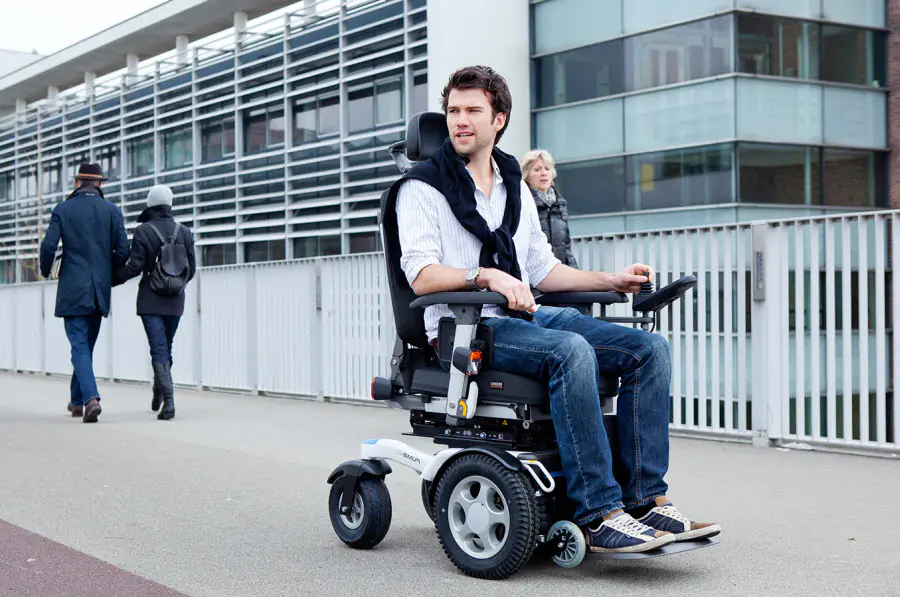An electric wheelchair is a wheelchair that does not operate due to the efforts of the user himself, but with the help of an electric drive. This allows you to solve a number of problems: it provides the opportunity for maximum human activity indoors and outdoors, the user can independently move over long distances (up to 40-50 km), including on sidewalks, in parks, shops, medical institutions, and on roads with poor coverage, on uneven and inclined surfaces. Read more.

Electric wheelchairs are quite heavy and take up more space than mechanical ones, but at the same time the movement is carried out at a given speed without physical effort, and your hands remain free. Some models allow you to set a specific route. The ride is smooth, without unnecessary vibration or shock.
This kind of independence and mobility is now available without the assistance of an accompanying person, including for patients with cerebral palsy, cardiovascular disease, arm weakness and paralysis of the upper and lower body.
Installation of electric wheelchairs and scooters
Electric wheelchairs and scooters run on batteries charged from the mains. On average, charging time is up to 8 hours, and operating time is 4 hours or more, depending on the type of battery. The electric motor allows you to reach speeds of up to 6-20 km/h.
All models are equipped with brakes, rollover protection, and seat belts. With the help of thicker wheels and special suspensions, you can overcome curbs and uneven roads. Control is carried out using a joystick, push-button or touch panels integrated into the armrest on the side of the leading hand. Specialized systems have been developed to regulate the movements of the head, chin or breathing of users who are paralyzed in the upper body.
Types of electric wheelchairs
By purpose: indoor - maneuverable and small models with folding footrests, their width is limited by doorways (optimal size - up to 60 cm in width), power reserve without recharging - up to 15 km at speeds up to 6 km/h; strollers - powerful and heavy strollers, hold a charge for a long time, reach speeds from 6 to 20 km/h, can reach a weight of up to 165 kg, and an average range of 40 km; scooters - can reach speeds of up to 15 km/h or more, hold a charge for 6 hours or more, but are only suitable for users with relatively intact motor capabilities.
Children's - lightweight and maneuverable models with a bright design and a modular design that “grows” with the child, suitable for use from 4 years of age;
With a verticalizer - they provide the ability to move to a vertical position, support the body with safety belts, allow you to engage muscles that are not used when sitting, and perform work that is inaccessible in a sitting position, including reaching the upper shelves;
By the number of wheels: three-wheeled - scooters for disabled people who are able to maintain a sitting position on their own, and the elderly with an anti-rollover system, maneuverable, have a small turning radius, best suited for indoor use; four-wheeled – electric wheelchairs and scooters with high stability for movement on the street.
By type of drive: rear-wheel drive - more powerful and stable, central-wheel drive - more maneuverable, front-wheel drive - stable, but difficult to control.
Use of electric wheelchairs for cerebral palsy
Electric wheelchairs can be used for cerebral palsy, as they allow you to move quickly using a small switch. They are recommended for limited mobility and problems with coordination in the upper and lower extremities.
Often, only such models enable patients to lead a relatively independent lifestyle, especially if motor abilities are severely limited in severe forms of the disease, including due to arm weakness. Such products are safe and help combat the stigmatization of children with cerebral palsy, significantly expand the boundaries of their independence, motivate them to get to know the world around them and communicate with peers.
A chair for this category of patients should be as adaptable as possible, have wide options for adjusting the size of the seat, footrests and backrest angle. It is mandatory to have seat belts, abductors, a headrest (if dictated by the physical condition of the user), and good shock absorption. Manufacturers have developed a variety of seats to suit various needs.
If head and neck support is not required, then it is permissible to pay attention to electric scooters. They help develop motor skills, but users must have the ability to maintain an upright spine and sufficient motor coordination to control them.



